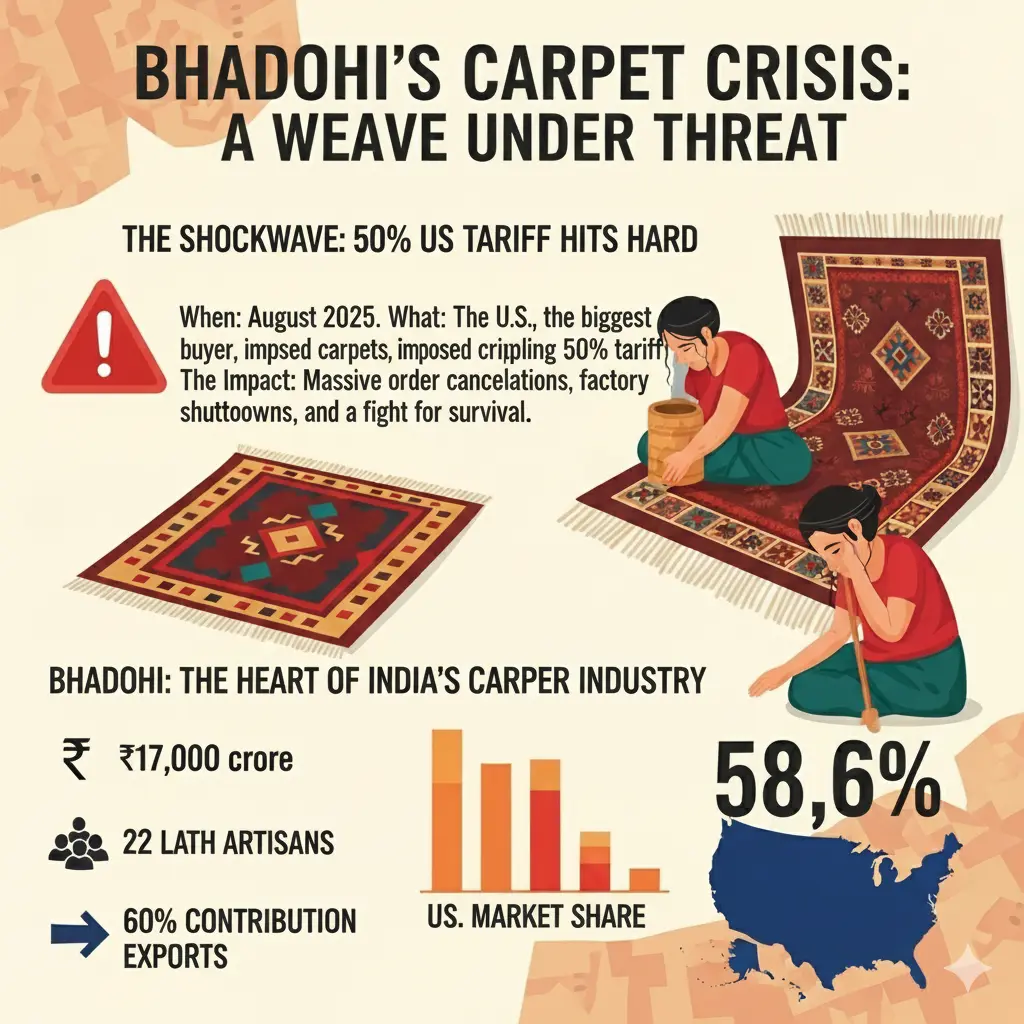September 12, 2025
Bhadohi Carpet Crisis: A Devastating Breakdown and 5 Steps to Survival
Impact of USA Tariff on State
Bhadohi Carpet: The handmade carpet industry in Bhadohi, Uttar Pradesh, is facing a severe crisis after the United States imposed a 50% tariff on India’s handmade carpet exports. This has led to massive order cancellations, factory shutdowns, wage losses, and a looming threat to the centuries-old craft that provides livelihoods to lakhs of artisans.
KEY POINTS: Impact of USA Tariff on State
Economic Importance of Bhadohi Carpet Industry:
- Bhadohi, along with Mirzapur and Varanasi, forms India’s largest handmade carpet hub.
- Uttar Pradesh contributes 60% of India’s handmade carpet exports (2024-25, CEPC report).
- Around 22 lakh rural artisans are involved in the carpet value chain in the region.
- There are 1,200 registered carpet exporters in Bhadohi (Textiles Ministry data).
- Handmade carpet export industry value: ₹17,000 crore.
Impact of the U.S. Tariff Hike:
- 50% tariff imposed by the U.S. in August 2025, disrupting the sector.
- The U.S. is the biggest buyer, accounting for 58.6% of India’s handmade carpet exports.
- Immediate effects:
- Sudden cancellation and renegotiation of orders.
- Wage delays and layoffs, with many workers unpaid or asked to wait indefinitely.
- Production cuts in factories, leading to economic distress.
- Threat to centuries-old craft knowledge and cultural heritage.
Historical Significance:
- Carpet weaving in Bhadohi dates back to the Mughal period.
- Mentioned in Ain-i-Akbari by Abu’l Fazl as a prestigious craft supported by Emperor Akbar.
- Carpets are luxury items, priced between ₹5,000 and several lakhs, depending on material and craftsmanship.
CHALLENGES / ISSUES:
- Trade and Economic Challenges:
- Sudden tariff barrier by the U.S., disrupting 60% of the export market.
- Over-dependence on one major market (U.S.).
- Rising cost of imported raw materials like New Zealand wool, making products less competitive.
- Global economic slowdown, reducing demand for luxury goods like handmade carpets.
- Livelihood and Social Impact:
- Thousands of weavers and artisans facing wage cuts, unemployment, and financial distress.
- Migrant artisans were forced to return to villages, increasing rural unemployment.
- Growing dependence on local moneylenders, leading to a debt cycle.
- Structural Issues in the Sector:
- Lack of diversified markets and modern marketing strategies.
- Insufficient government support for skill development and modernization.
- Informal nature of employment, leaving workers without social security or job protection.
- Cultural Threat:
- The traditional craft is at risk, with younger generations moving away due to low wages and instability.
- Possibility of loss of centuries-old artisanal knowledge.
STEPS NEEDED / WAY FORWARD
- Trade & Market Diversification:
- Engage diplomatically with the U.S. to negotiate tariff reduction or secure a trade agreement.
- Explore alternative export markets like Europe, Middle East, and Asia to reduce dependency on the U.S.
- Develop domestic markets through campaigns like Vocal for Local.
- Government Support:
- Provide direct financial assistance or a relief package to affected weavers and exporters.
- Subsidize raw material costs to maintain competitiveness.
- Ensure timely wage support schemes for artisans, similar to MGNREGA for rural employment.
- Industry Modernization:
- Introduce design innovation hubs in collaboration with IITs and NIFT to modernize carpet designs.
- Promote digital platforms for e-commerce, enabling direct export and cutting out middlemen.
- Establish quality certification and branding, such as Geographical Indication (GI) tags.
- Skill Development & Social Security:
- Launch training programs for young artisans to preserve traditional skills.
- Provide health insurance, pensions, and minimum wage protections to weavers.
- Formalize the workforce to bring them under government welfare schemes.
- Cultural Preservation:
- Promote Bhadohi carpets as heritage products through exhibitions and global branding.
- Set up carpet museums and craft centers to attract tourism and raise awareness.
CONCLUSION
The Bhadohi carpet crisis reflects vulnerabilities in India’s export-driven craft sectors due to global trade shocks. Immediate government intervention, diversification of markets, and structural reforms are essential to protect livelihoods, preserve cultural heritage, and ensure the long-term sustainability of this globally acclaimed craft.
September 9, 2025
September 8, 2025
September 4, 2025
September 1, 2025

